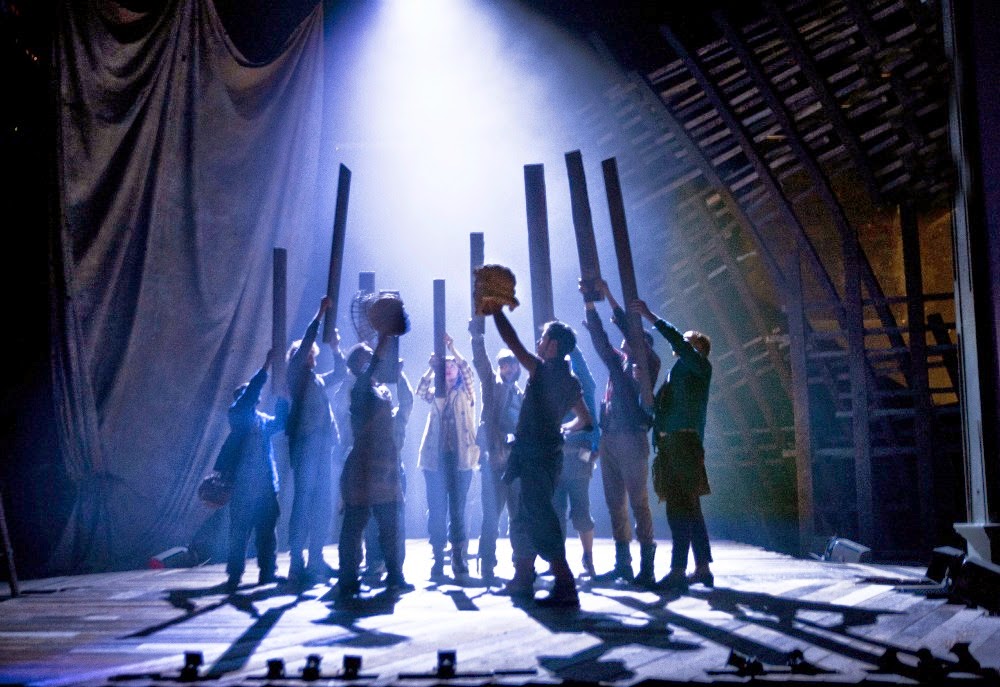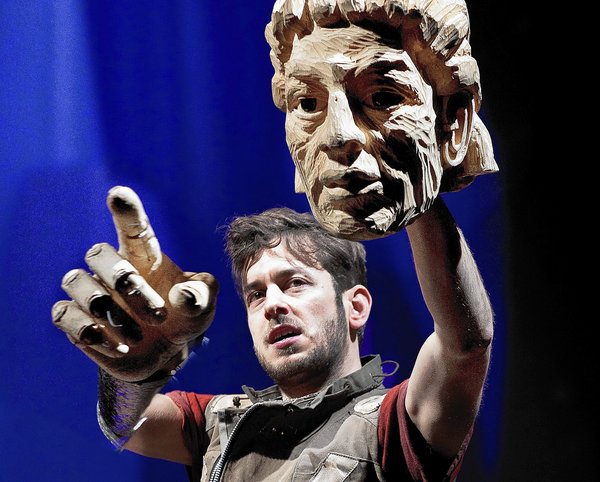“A Midsummer Night’s Dream,” one of Shakespeare’s oft produced comedies, is a tale of lovers led astray and then back together with the prodigious help of fairy meddling. Not to mention the hapless bumblings of a group of mechanicals turned actors for the wedding festivities. Midsummer is a fun, easily accessible script and as such it is done a lot. One might say that it is overdone – there will be at least two more productions of this play in the Los Angeles area before the end of the summer. Therefore, the key to producing this play is to come up with some new way to present or illuminate the material. This production, from Bristol Old Vic in association with Handspring Puppet Company, does just that.
The play starts out in what appears to be Hippolyta’s workshop. Tools, loose boards and bits of projects are strewn throughout the space and a dramatic floor to ceiling draped drop cloth and pallet-like backdrop help define the space on two sides. Vicki Mortimer’s design is gritty yet beautiful in the way that the actors are able to easily flow in and out of and interact with it. Philip Gladwell’s lighting design further intensifies this by providing a harshness when actors become entangled in the set elements and a softness when all are working as one.
That the setting is Hippolyta’s workshop is fitting, because this production emphasizes the fact that Hippolyta is essentially a spoil of war for Theseus and therefore is a resigned instead of a giddy bride. Much like Titania is resigned to stay in Oberon’s bad graces since she refuses to part with her changeling boy. Saskia Portway, as Hippolyta/Titania, and David Ricardo-Pearce, as Theseus/Oberon, set this tone perfectly. As such, the play becomes both Theseus’ and Oberon’s opportunity to win over their respective women. Ricardo-Pearce and Portway command such a presence in these roles that they are more memorable than the lovers or the mechanicals, who generally steal the show.
While they are not as big and breathtaking as those found in “War Horse,” the puppetry supplied by the Handspring Puppet Company added significantly to this production. All of the puppets, or elements of the puppets, come from found items in the workshop. Puck, played by three actors, is a hodgepodge of tools that float ethereally to form the impish sprite. Titania and Oberon both have large face masks to represent their fairy royalty and Oberon has a giant puppet hand as well. The nuance and emotionality that Ricardo-Pearce is able to convey through his puppetry work is astonishing.
However, the most successful aspect of this production is the choreography with the loose boards scattered about the set. These boards are used by the ensemble to create a living, breathing environment for the action. The scene in which Hermia, played by Akiya Henry, and Helena, played by Naomi Cranston, argue with each other in the forest was given new life by the seemingly fairy enchanted boards that kept Lysander and Demetrius, played by Alex Felton and Kyle Lima respectively, at bay.
Sadly, it is the biggest and most intricate puppet that is the least effective. Bottom’s transformation into the ass provided a big laugh initially and a few later, however the shock value aside, this transformation is more distasteful than funny. This puppet/human conglomeration is a very literal interpretation of an “ass” and hugely awkward. The puppet was cumbersome, moved stiffly and removed any chance of subtle interaction with Titania. Despite Miltos Yerolemou’s valiant efforts, Bottom’s lines are muffled at best and indecipherable at the worst. The type of middle school locker room humor that these scenes rely on are incongruous with the rest of the production and ineffective in that they rely upon the same joke over and over again. In contrast with the clever bits and gags – including a fair number of innocuous crotch jokes – that are littered throughout the rest of the play, these fell sadly short. The most disappointing part of the whole thing is that Yerolemou was fantastic before and after the transformation, so it would have been interesting to see what he could have done as an unencumbered “ass.”
This cast is marvelous and integrates the wonderful mixture of everyday objects with the intricate work of Handspring Puppet Company seamlessly. All in all, this production provides a new vitality to what can be an overdone script. In case you hadn’t caught on, I’m not a big Midsummer fan, but even I liked this one.
*Coverage provided for the Culver City News


